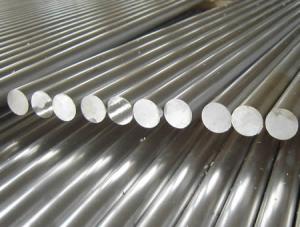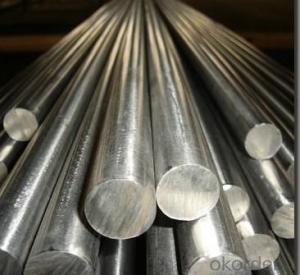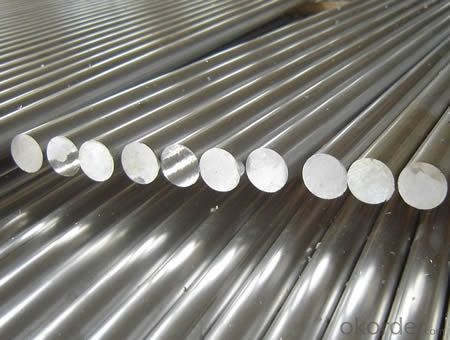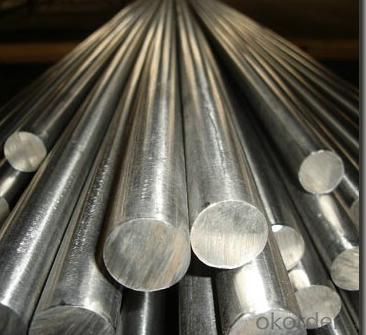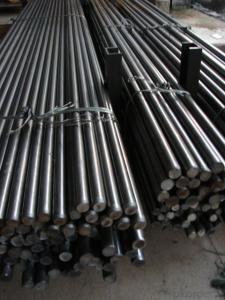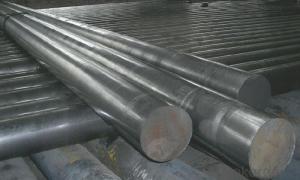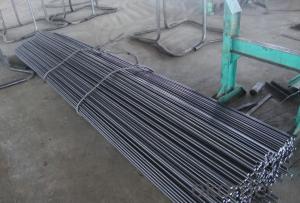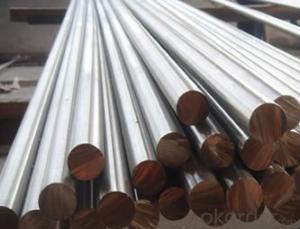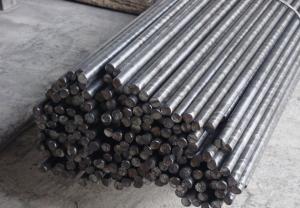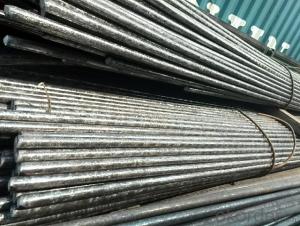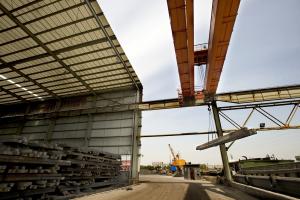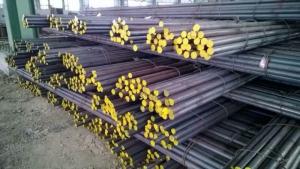Cold Drawn Steel Round Bar with High Quality-50mm-75mm
- Loading Port:
- China Main Port
- Payment Terms:
- TT or LC
- Min Order Qty:
- 100 m.t
- Supply Capability:
- 10000 m.t/month
OKorder Service Pledge
OKorder Financial Service
You Might Also Like
Cold Drawn Steel Round Bar with High Quality-50mm-75mm
Product Description:
Specifications:
1.Size: 50mm-75mm
2.Material: AISI 1045/DIN 1.1191/JIS S45C/GB 45/EN8.
3.Chemical analysis:
C | Si | Mn | P≤ | S≤ | Cr |
0.40~0.60 | 0.20~0.30 | 0.70~0.90 | 0.030 | 0.030 | 0.01~0.03 |
4.Process: EAF + LF + VD + Forged + Heat Treatment (optional)
5.Delivery condition:Hot forged +Rough machined (black surface after Q/T)+ Turned (optional)
6.Technical Data: Chemical Composition, Physical Properties and Mechanical Testing.
7. Test: Ultrasonic test according to SEP 1921-84 3C/c.
8. Standard: GB, AISI, ASTM, DIN, JIS, BS, etc.
9. Quality Management Certification: ISO 9001:2008.
10. Main application:
(1)It is widely used in machinery manufacturing.
(2) For the manufacture of high strength requirements parts, such as gears, shafts, piston pin and the uneven force big machining parts, forgings, stampings and bolts, nuts, pipe joint.
FAQ of Cold Drawn Steel Round Bar with High Quality-50mm-75mm:
Q1: Why buy Materials & Equipment from OKorder.com?
A1: All products offered byOKorder.com are carefully selected from China's most reliable manufacturing enterprises. Through its ISO certifications, OKorder.com adheres to the highest standards and a commitment to supply chain safety and customer satisfaction.
Q2: How do we guarantee the quality of our products?
A2: We have established an advanced quality management system which conducts strict quality tests at every step, from raw materials to the final product. At the same time, we provide extensive follow-up service assurances as required.
Q3: How soon can we receive the product after purchase?
A3: Within three days of placing an order, we will arrange production. The shipping date is dependent upon the quatity, how many sizes you want and the plan of production, but is typically 1 month to 2 month days from the beginning of production.
Images of Cold Drawn Steel Round Bar with High Quality-50mm-75mm:
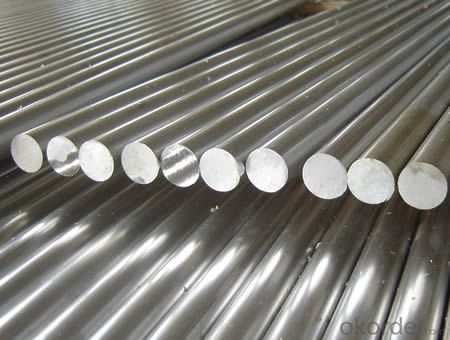
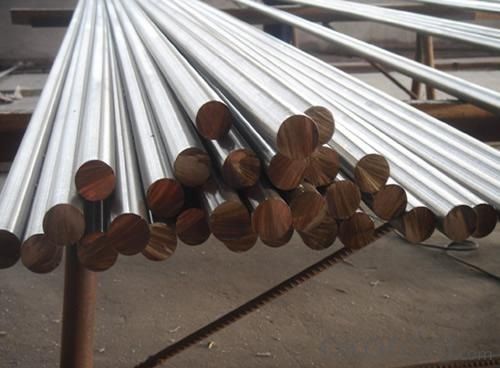
- Q: What are the different types of steel round bars used in the automotive drivetrain systems?
- There are several types of steel round bars commonly used in automotive drivetrain systems, including alloy steel, carbon steel, and stainless steel. These bars are chosen based on their specific properties and characteristics, such as strength, durability, and resistance to corrosion. The selection of the type of steel round bar depends on the specific application and requirements of the drivetrain system.
- Q: How do you calculate the bending stress in a steel round bar?
- The bending stress in a steel round bar can be calculated using the formula: Bending Stress = (Moment * Radius) / (Section Modulus). The moment is calculated by multiplying the applied force by the distance from the force to the center of the bar. The radius is the radius of the round bar, and the section modulus is a property of the bar's cross-sectional shape that indicates its resistance to bending.
- Q: Can steel round bars be used in the manufacturing of hydraulic components?
- Indeed, the utilization of steel round bars is feasible for the production of hydraulic components. Owing to its robustness, endurance, and corrosion resistance, steel is widely employed in the fabrication of hydraulic components. By molding and machining steel round bars, an assortment of hydraulic components, including pistons, cylinders, valves, and fittings, can be manufactured. The adoption of steel round bars guarantees the capability of withstanding elevated pressures and maintaining optimal performance across diverse hydraulic systems.
- Q: Can steel round bars be extruded?
- Steel round bars cannot be extruded; instead, they are typically produced through a different process called hot rolling. In hot rolling, a cylindrical billet is heated and passed through a series of rollers to achieve the desired diameter and length. Extrusion, on the other hand, is a manufacturing process that involves forcing material through a die to create specific shapes or profiles. While steel can be extruded into various shapes such as tubes, channels, or angles, round bars are not typically produced in this way.
- Q: What are the different grades of heat-treated steel round bars?
- There exists a variety of heat-treated steel round bars with distinct properties and characteristics. Among the commonly used grades are: 1. 4140: Renowned for its high strength and toughness, this grade of heat-treated steel round bar possesses exceptional wear resistance and good machinability. It can undergo easy heat treatment to enhance its hardness and strength. 2. 4340: Heat-treated steel round bars belonging to this grade are recognized for their high tensile strength, toughness, and resistance to fatigue. They find extensive use in industries like aerospace and automotive, which demand superior strength and durability. 3. 8620: Characterized by its case hardening properties, this grade of heat-treated steel round bar exhibits good core strength, excellent toughness, and is frequently employed in applications requiring high wear resistance, such as gears, shafts, and pins. 4. 52100: Widely utilized in bearing applications, heat-treated steel round bars of this grade offer exceptional hardness, wear resistance, and high fatigue strength. They are specially designed to withstand heavy loads and provide long-lasting performance. 5. 1045: Recognized for its medium carbon content, this grade of heat-treated steel round bar provides good strength and impact resistance. It is commonly employed in applications that necessitate moderate strength and toughness, such as shafts, axles, and machinery parts. These examples represent only a fraction of the diverse grades of heat-treated steel round bars available in the market. The choice of grade depends on specific requirements like strength, hardness, toughness, and wear resistance. Seeking guidance from a knowledgeable professional is essential to determine the most suitable grade for one's particular needs.
- Q: What are the different surface treatments for steel round bars?
- There are several different surface treatments available for steel round bars, each serving a specific purpose and providing unique benefits. Some of the most common surface treatments for steel round bars include: 1. Hot-dip galvanizing: This process involves immersing the steel round bars in a bath of molten zinc, which creates a protective coating that helps prevent corrosion and rusting. Hot-dip galvanizing is an effective treatment for steel round bars used in outdoor or corrosive environments. 2. Painting: Applying a coat of paint to the surface of steel round bars not only enhances their appearance but also provides a protective barrier against moisture and oxidation. Painting is commonly used for decorative purposes or when a specific color is desired. 3. Powder coating: Powder coating involves applying a dry powder to the steel round bars, which is then cured under heat to form a durable and attractive finish. This treatment offers excellent resistance to impact, chemicals, and UV rays, making it suitable for various applications. 4. Electropolishing: This process uses an electric current and an electrolyte solution to remove a thin layer of the steel round bars' surface, resulting in a smooth and shiny finish. Electropolishing improves the appearance and corrosion resistance of the steel, making it ideal for applications that require a high level of cleanliness and aesthetics. 5. Passivation: Passivation involves treating the steel round bars with an acid solution to remove any free iron or iron oxide from the surface, thus enhancing their corrosion resistance. Passivation is commonly used for stainless steel round bars to increase their longevity and prevent staining or rusting. 6. Shot blasting: Shot blasting is a mechanical surface treatment that involves bombarding the steel round bars with small steel balls or particles at high velocity. This process removes any surface contaminants, scale, or rust, resulting in a clean and roughened surface that improves adhesion for subsequent coatings or treatments. 7. Chrome plating: Chrome plating is a technique where a thin layer of chromium is electroplated onto the surface of steel round bars. This treatment provides excellent corrosion resistance, wear resistance, and a shiny appearance, making it suitable for applications that require durability and aesthetics. Overall, the choice of surface treatment for steel round bars depends on the specific requirements of the application, such as corrosion resistance, aesthetics, or wear resistance. It is important to carefully consider the intended use and environmental conditions before selecting the most appropriate surface treatment for steel round bars.
- Q: What is the yield strength to tensile strength ratio of a steel round bar?
- The yield strength to tensile strength ratio of a steel round bar, also known as the yield-to-tensile ratio, is an important mechanical property that indicates the material's ability to withstand deformation before it fails under tension. This ratio is typically used to evaluate the ductility and brittleness of a steel bar. In general, the yield strength is the stress at which a material begins to exhibit plastic deformation, while the tensile strength is the maximum stress the material can withstand before it fractures. The yield strength to tensile strength ratio is calculated by dividing the yield strength by the tensile strength. The yield-to-tensile ratio varies depending on the specific grade and composition of the steel being used. However, for most common structural steels, the yield-to-tensile ratio typically falls within the range of 0.6 to 0.8. This means that the yield strength is generally around 60% to 80% of the ultimate tensile strength. A higher yield-to-tensile ratio indicates a more ductile and less brittle steel, as it suggests that the material can undergo substantial plastic deformation before ultimate failure. On the other hand, a lower yield-to-tensile ratio indicates a more brittle steel, which is prone to fracture at lower levels of deformation. It is important to note that the yield-to-tensile ratio is just one of many factors to consider when evaluating the mechanical properties of a steel round bar. Other factors such as hardness, toughness, and elongation also play significant roles in determining the overall performance and suitability of the steel for a particular application.
- Q: Are steel round bars corrosion-resistant?
- Yes, steel round bars can be corrosion-resistant depending on the type of steel used and any additional protective coatings or treatments applied.
- Q: How do you calculate the weight of a steel round bar based on its length and diameter?
- To calculate the weight of a steel round bar based on its length and diameter, you can use the following equation: Weight = (π/4) x (Diameter^2) x Length x Density Here, π represents the mathematical constant pi (approximately 3.14159), Diameter is the measurement of the steel round bar across its widest point, Length is the overall length of the bar, and Density is the density of steel, which is typically around 7850 kilograms per cubic meter. To calculate the weight, first square the diameter, then multiply it by the length and density. Finally, multiply the result by π/4 to obtain the weight of the steel round bar in the desired units (typically kilograms or pounds). It's important to note that this equation assumes the steel round bar is a solid cylinder with a uniform diameter. If the bar has any variations or irregularities, the weight calculated using this equation may not be entirely accurate.
- Q: Are steel round bars suitable for use in the marine industry?
- Steel round bars are a great choice for the marine industry. They are made of strong and durable material, which makes them perfect for marine use. In the marine industry, where there are harsh environmental conditions like saltwater, waves, and corrosion, steel is an excellent option. Steel round bars have exceptional tensile strength and can withstand impact, making them suitable for various marine components such as shipbuilding, offshore structures, and marine equipment. Moreover, steel is readily available, cost-effective, and can be easily customized to meet specific requirements, making it a popular choice in the marine industry. However, it is crucial to choose the right grade of steel, like stainless steel, which has good corrosion resistance. This ensures long-term durability and performance in marine environments. It is also important to regularly maintain steel round bars in marine applications, including proper coating and protection against corrosion, to enhance their lifespan.
Send your message to us
Cold Drawn Steel Round Bar with High Quality-50mm-75mm
- Loading Port:
- China Main Port
- Payment Terms:
- TT or LC
- Min Order Qty:
- 100 m.t
- Supply Capability:
- 10000 m.t/month
OKorder Service Pledge
OKorder Financial Service
Similar products
Hot products
Hot Searches
Related keywords
